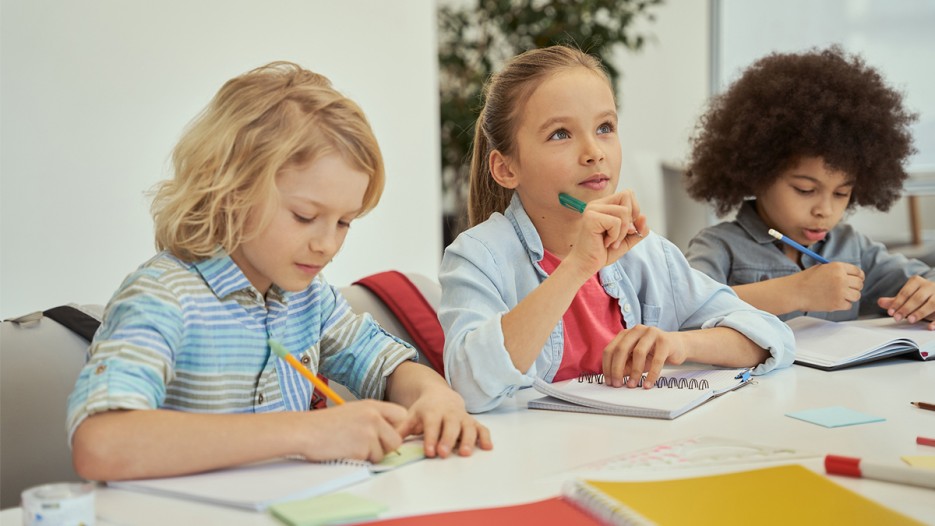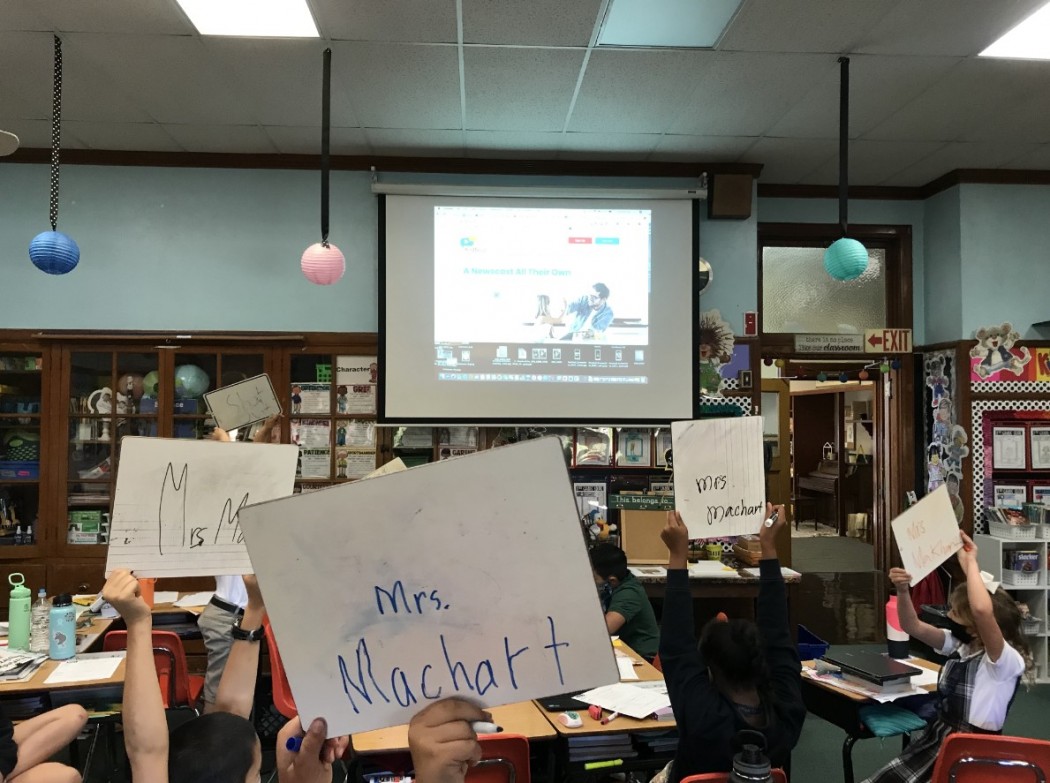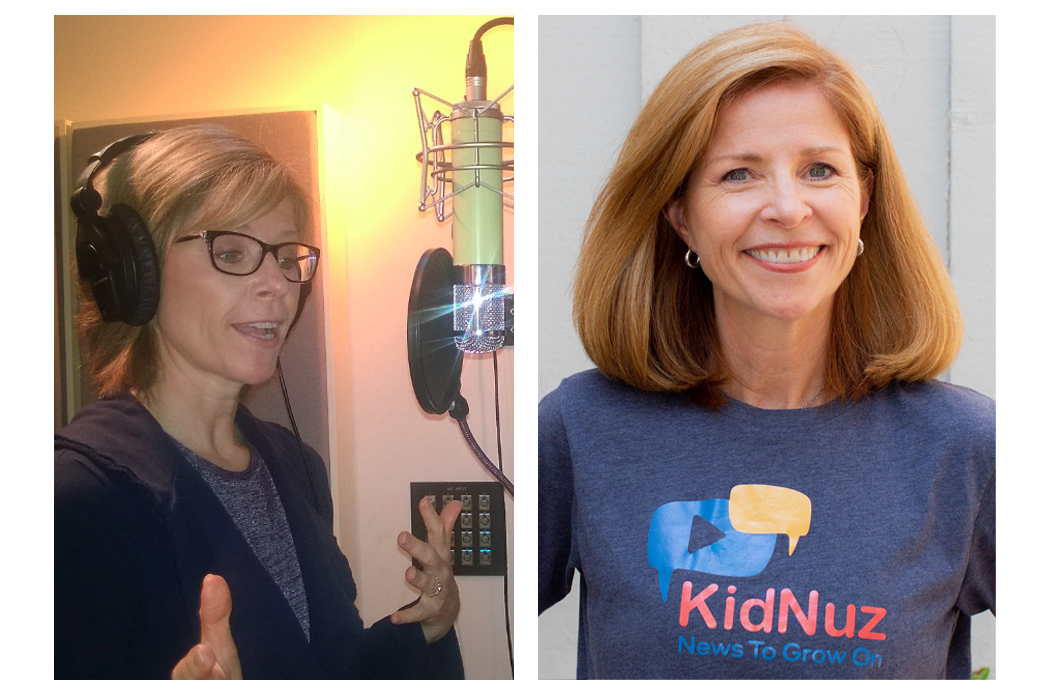Tori Nelson is one of the four co-founders of the nonprofit KidNuz, a daily news podcast for kids, parents, and educators. As a former broadcast journalist, Nelson is passionate about news education, and she believes kids should start listening in on world (and neighborhood) events in a fun, kid-friendly way.
Our conversation with Nelson sparked contagious curiosity. We learned about how to incorporate current events into a classroom, the best ways to strike up insightful conversations with your kids, and so much more. We hope you enjoy it as much as we did…
KidNuz has a foundation of accessibility and understanding for kids based on the vision you share with the other three co-founders. What do the four of you share in your conviction and passion that originally lead you to KidNuz?
Tori Nelson: Between the four of us, we have 12 kids and nine Emmys. We know kids, and we know news. The common thread is that we’re all very passionate about the news. I love being one of the first to know what’s going on in the world, and I love telling people about it. That’s been true since I first started in the business. It hasn’t changed, but people of all ages now have access to news, and that isn’t necessarily a good thing, especially if it’s not age-appropriate. There are age-appropriate movies, age-appropriate books, and I think there should also be an age-appropriate form of news to get kids tuned into what’s happening outside of their little bubble without being harmful. A lot of news is geared toward adults, and it can be harmful for young ears and eyes.
That was the initial glue that bonded us together and gave us the energy and impetus to get KidNuz started.
All 4 co-founders bring something different to the table from their backgrounds in the news industry. What does that diversity of perspective contribute to your vision for your KidNuz audience?
TN: We all worked at the same TV station in the San Francisco market. We’d had various experiences, but as Ro, our editor-in-chief, said, we were kind of one-trick ponies. However, we’d been fortunate to attract some very talented people to KidNuz, like our treasurer and our creative director. We also have someone helping us fundraise, and we have a former educator.
We bring people on board to fill the gaps that we can’t provide ourselves. We’re growing a group of advisors to make sure we’re covering all our bases and creating the best and strongest team we can to keep going forward.
This takes passion because we’re a nonprofit. It’s not a big money-maker, so people do this because they believe so strongly in the mission.

KidNuz releases a new episode every weekday. What is the motivation behind that decision, and what does the process of putting it together look like?
TN: It’s a lot like any newscast. We all worked on a morning newscast that was 5 days a week, so we know that news never stops. Essentially, we want to get the kids in the habit of expecting to tune in daily to figure out what’s going on in the world. We just finished up our second survey, and around 70-80% of the survey respondents said they listen 5 days a week.
A lot of podcasts have the problem where people will listen for a little bit and then drop off, and around 92% of KidNuz listeners listen the entire way through. They want to hear the teacher shoutouts at the end, so we include a little hook to keep them tuned in.
Putting together a 6-minute podcast takes about eight hours of combined work. It’s not a short, easy process, and because we have very high standards and want it to be the best quality we can, we put time and effort into it. It’s a challenge, but it’s worth it.
I noticed that you do a lot of research, writing, and anchoring for the podcast. That’s a lot of different roles! How does being a voice on the podcast and immersing yourself in news research influence the way you function as a leader of KidNuz?
TN: It’s helpful to be intimately knowledgeable about different aspects of the organization. For a while, I was the only one doing the writing and anchoring. Writing is the hardest part because you have to do all the research, and there’s lots of news out there, but it’s all pretty depressing. You really need to dig through various websites to find a KidNuz-worthy story. It doesn’t have to be super serious, and we try to have a lot of fun stories, but I like to have some serious, hard news stories. We have to be careful if it’s political to remain neutral and unbiased.
I was an anchor for a long time, and I had done writing, but I knew nothing about the technical side. I had to learn all about producing, uploading to the platform, adding sound effects, and editing. It’s a sense of accomplishment, and it’s nice to learn some new things. I’m also the board president, kind of by default, so I stay involved in a lot of different aspects. It’s helpful to know a lot of what’s going on so I can make better decisions and better analysis of how things are going as a leader of the team.
Further reading: KidNuz Editor on Remaining Nonpartisan on KidNuz.
What is your mindset in your search for KidNuz-worthy stories?
TN: I ask myself, “How would a third to sixth grader look at this story? Would they care, or should they care? How can I make it interesting to them and informative?"
Usually, I try to stay away from any depressing stories that involve death, like school shootings or plane crashes. When the earthquake in Turkey first happened, we stayed away from it, but by the end of the week, it reached a “too big to ignore” status. We never mention the death toll of the earthquake, but we talk about the survivors and the rescues.
With the war in Ukraine, we talk about how kids were helping other families and collecting teddy bears for some of the refugees. We try to look at the positive side. One thing we love to look for is a child a little bit older than our normal audience, like a 14-year-old. I did a story on Valentine's Day about a 14-year-old kid who recruited kids from six schools to make handmade Valentine cards and sent 16,000 of them to nursing homes, hospitals, and nonprofits. Something that a kid their age or close to their age could do. Ordinary kids can do extraordinary things, so it might be an inspiration to them.
We want the kids to know that the world is okay. Yes, there are a lot of problems, but there is good in the world.
Further reading: Listen to or read the Valentine’s Day story from KidNuz.
I love that you’re focusing on kids’ perspectives in the bigger news events so that it’s more relatable and might develop more empathy for your listeners. Can you tell me more about that?
TN: Initially, we were looking at the age range of 6-13, but the sweet spot has naturally fallen on 8–12-year-olds. That’s the age they’re starting to develop a sense of other and of things outside their bubble and their community. They have an innate curiosity, but they’re still innocent and open-minded.
We have three branches of listeners – the kids, the parents, and the teachers. All three really seem to be enthusiastic about the podcast. We hear so often that it sparks good conversations, often on difficult topics. The adults really appreciate that we introduce a topic that might have been hard to bring up with kids.
The way I like to describe it is that KidNuz is a door. If we bring up a topic and then the adult listening wants to go deeper into that topic, they can open the door and go down that path. If the adult listening feels that the child isn’t ready to go more in-depth, they can keep that door closed and move on to the next story.
That’s why we try hard to earn and maintain the trust of adults. We’re not going to go somewhere inappropriate that a child isn’t ready to hear. We have to skew towards the younger side of the audience, but if the adults want to go deeper, they can. We are not the be-all and end-all of news sources, but we can be a starting point.
What are some of the creative ways you’ve seen teachers use your podcast in their classrooms?
TN: We just started our second teacher advisory panel, where we recruit 10-12 teachers every year to be sounding boards and hear how KidNuz is working and can do better. Some fourth and fifth-grade teachers have had their kids create their own podcast in the style of KidNuz. They’ll do a report, a few little stories, and a quiz.

Photo provided by Tori Nelson
Tell me more about your interaction with young KidNuz listeners around the world.
TN: We have our email – WeHearYou@KidNuz.org – so each of the four founders has one or two days a week to check it. It’s always interesting to see the comments that we get. Sometimes kids will say something like, “Can you do more stories on peacocks?” So, I keep my eye out for stories on peacocks!
The thing that’s becoming big is the classroom shoutouts. Teachers love it. We get videos of when a classroom gets a shoutout, and the whole classroom explodes. What was really touching for me was during COVID, when all the classrooms were virtual. A lot of teachers said that getting a classroom shoutout gave them a sense of unity and being together as a team. It was a small thing, but every little bit helped during that tough time.
The kids thank us for giving them a seat at the table. They now know enough about what’s going on that they can have a conversation with adults. It’s so important to have that engagement.
We’ve had some comments that students listen overseas to help them learn English. If they’re learning English as a second language, tuning into a child’s program from native speakers is helpful because it’s basic vocabulary and simplistic sentence structure. We also provide written transcripts on our website so that students with reading or learning disabilities can listen and read along at the same time. That can be very helpful.
Recently, we got contacted by the government of Taiwan to put a link to KidNuz on their bilingual counsel resource website.
Do you think that parents listening to KidNuz alongside their kids develop a different perspective of the news as an adult?
TN: Yeah! I have so many adult friends, with or without kids, who like listening. They learn, and things are explained at a simpler level. Parents listening with their kids have something in common to talk about, and it can start a conversation.
At first, we visualized this as something parents would listen to at breakfast time or while driving to school, and many families do, but it also became a really big thing for teachers to listen in the classroom. We didn’t expect that, but a lot of teachers say there’s not room in the curriculum for current events, and they can be a little sticky because of political leanings. They find that we cover the right topics in the right way, and it’s the perfect length of time. They often play it in the morning when they’re taking attendance.
One teacher on our teacher advisory panel said that the six minutes that they listen to KidNuz were the quietist six minutes of her day. The kids listen so carefully because they want to get the quiz right, which provides a reward at the end.
Having an audio-only experience with podcasts opens up the imagination.
Another educator reached out to us and said he was putting together worksheets once a month where he takes some KidNuz stories and expands on them to help work on kids’ critical thinking. For example, “There's a space program, and they’re spending 800 billion dollars. Do you think that’s the best use of money? How else would you use that money? If you were going to space, what would you bring?”
A lot of teachers say that, because of the quiz, the podcast really helps improve kids’ listening comprehension, which is great. There are all these extra things we didn’t anticipate!

How does listening to the news in the KidNuz format prepare kids to navigate the broader scope of the news world when they get older?
TN: Our goal is that it gets them in the habit of consuming news. Eventually, they’ll realize that there is bad news out there, but it doesn’t always have to be bad. You can look for the positives. For me, it’s so paramount to help kids understand the importance of news. Democracy is dependent on freedom of the press. In some countries, journalism is suppressed, and it’s a real problem because you don’t know what’s going on. That’s why we feel that if we can start kids in that habit at a younger age, they will grow up and expect quality journalism, not just random opinions.
We always try to say what our sources are so that kids understand this isn’t stuff we’re making up. It’s being recorded in legitimate, professional journalism. We try to get a wide variety of sources, and we hope that kids will do the same thing. If you get a wider variety of news, you get a healthier perspective on the world. Even the best quality news can still have a certain way of looking at things. The broader variety of news you can consume, the better off you are, and the better off society is in general.
We also want kids to be respectful of others, so we keep it as diverse and equitable as possible.
In our Q&A with Sean Herman from Kinzoo, he brought up the idea of business model being a direct indicator of how private an app or platform for kids is. He encouraged parents to watch out for persuasive marketing efforts like endless feeds, and to find out where a developer is getting their money before allowing their kids on an app. How do business model and persuasive marketing weigh into the news industry, and how can parents equip their kids to be discerning in choosing what news sources to trust?
TN: KidNuz is 100% nonprofit, and we get pretty much 100% of our revenue from donations. A lot of it is episode and quiz sponsorships, which is great.
Parents should look carefully because you can go to websites of different podcaster news sources and see where the funding comes from. Sometimes it’s coming from a particular party, which could mean the news will have an agenda. We try to be clear that we are 100% committed to being non-biased. That’s a huge part of our core.
If you or your child is listening to something on a regular basis, it’s important to know what the background is, and what’s going on behind the scenes.
What is your favorite news story that you’ve shared on a KidNuz podcast?
TN: There are so many, I just love them. The one that sticks with me is this little boy who got teased at school. His sister had a sewing machine and taught him how to sew. He would make bow ties for himself and wear them, and then he went to an animal shelter with his parents and noticed all these older dogs not getting attention. He had the idea of making bow ties for the unwanted dogs, and then they all got snapped up.
I love the way that he thought about that. It was so smart. Now, he’s making all these ties for animal shelters. And the dogs with bow ties are getting adopted.
We had another one about a kid who had learned about standing up for what you want in a class. He decided to stand up and organize a protest because they got rid of chocolate milk in his school. He wanted the chocolate milk back, so they came up with a compromise to offer it once a week or something like that.
We’re looking for stories that kids can relate to. We don’t want to be overly preachy, but we want to include a lesson.

Photos provided by Tori Nelson
If you enjoyed this Q&A, check out KidNuz!
Other podcasts to check out:
Tumble: A Science Podcast for Kids